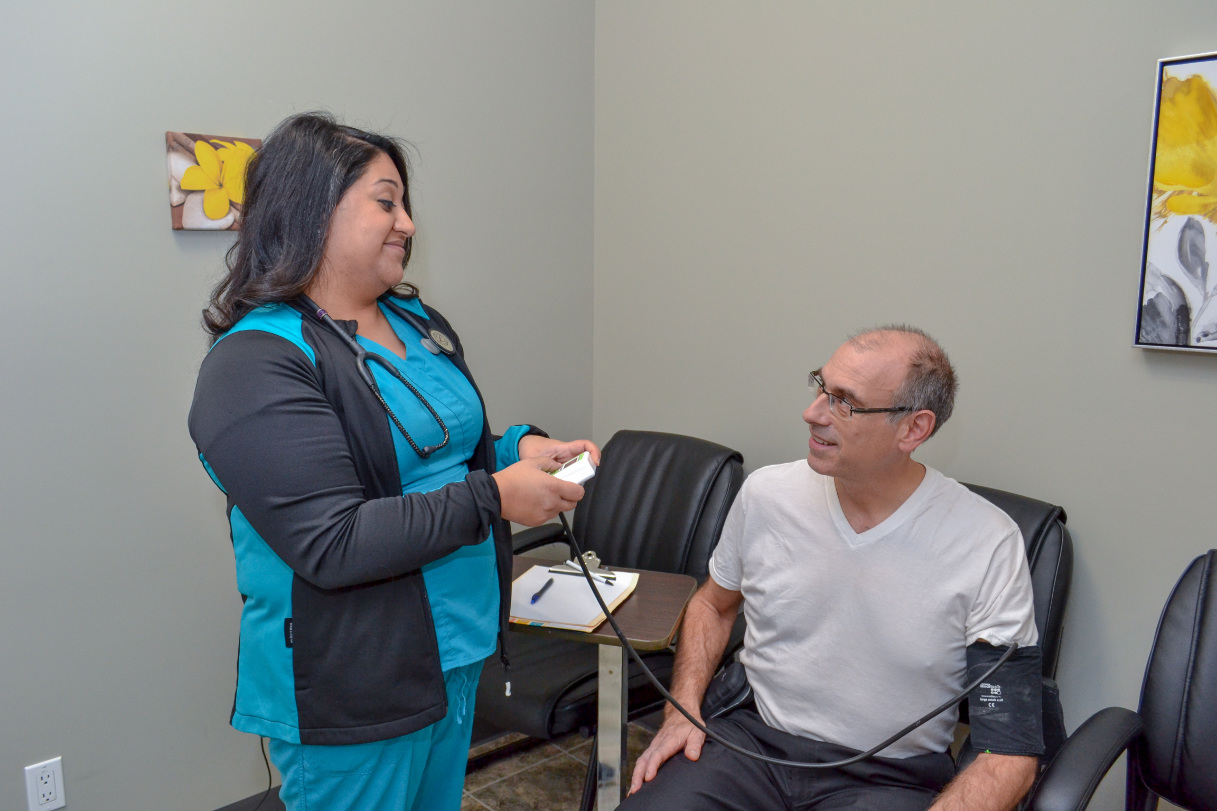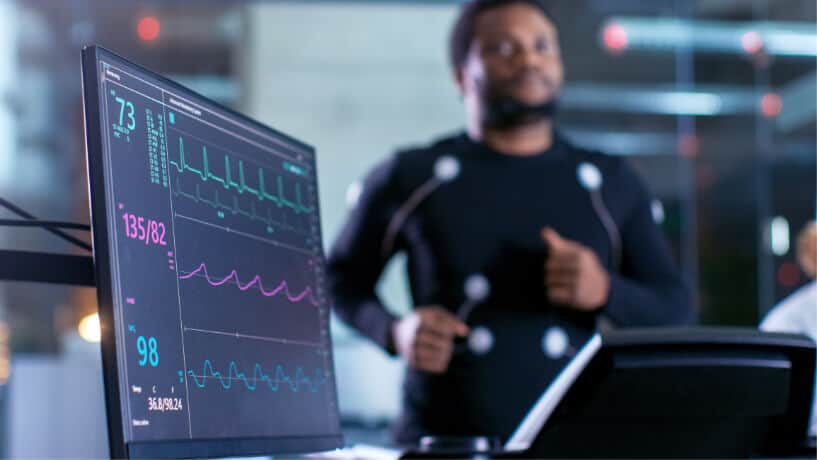Myocardial Perfusion (MIBI)
Myocardial perfusion imaging (MIBI), otherwise known as a nuclear stress test, evaluates blood flow to the heart at rest and under stress. This test specifically examines blood flow through the coronary arteries to the heart and gives a more complete assessment on the presence of cardiovascular disease (CVD).
Cardiovascular disease, such as atherosclerosis, occurs when one or more of the arteries supplying blood to the heart are partially blocked due to plaque formation along the arterial walls. This results in myocardial ischemia, which is a decrease in the blood circulation to the heart muscle. This can cause symptoms such as chest pain or shortness of breath.
Myocardial Perfusion Requirements
Myocardial perfusion imaging requires dilated blood vessels to mimic stress. Most patients can achieve this by walking or running on a treadmill. However, there are a few reasons why a patient will not be asked to use the treadmill. In these cases, our team will administer a drug called Dipyridamole to simulate the effect of stress on the heart by dilating blood vessels around the body. If you receive Dipyridamole, you may feel short of breath or develop a mild headache. This will be easily and quickly reversed with the antidote, Aminophylline.
A MIBI scan also uses a radiopharmaceutical tracer to clearly image blood flow to your heart. This process, also known as perfusion, is captured by a “gamma” camera to help us determine if your heart is getting enough blood under different circumstances, such as with narrowed arteries. Occasionally, your doctor may refer you for a MIBI to evaluate blood flow after a major heart procedure such as a stent or bypass.
A nuclear stress test can also help determine angina symptoms and is useful in assessing possible heart damage after a heart attack. This exam has many names, the most common being Sestamibi cardiac scan, myocardial perfusion, and nuclear stress test. Insight Medical Imaging provides nuclear stress tests at our Meadowlark and Millwoods cardiac clinics.
MIBIs For Female Patients
Since the tracer used in this procedure is radioactive and circulates throughout the body, it is crucial that there is zero chance you may be pregnant and that you are not breastfeeding. Before your exam, our technologist will ask you when you had your last menstrual period. This is to confirm that there is zero chance we expose an unborn baby to radiation and prevent severe health effects.
Unborn babies are particularly sensitive to radiation between weeks 2 and 15 of development. If you have any doubts or think you may be pregnant, please tell our technologist before your exam. Learn more about radiation risk prevention for pregnant and breastfeeding women.
What Happens During my MIBI?
- A MIBI will require several hours of your time each day for two days.
- This exam consists of two separate tests administered over two business days. Sometimes the second test is scheduled up to five business days later due to patient availability. The first day is typically a “rest test” while the second is a “stress test.”
- Occasionally, the rest and stress test days are reversed by your technologist.
- At the time of booking, you will be given specific preparation instructions. These instructions are slightly different if you are diabetic in order to accommodate fasting and blood sugar fluctuations. It is extremely important that you follow these carefully. To review the prep instructions, click here.
- Our team is happy to answer any questions you have to ensure you are properly prepared for your exam.
Day 1 – Resting Test
- The first day is usually a “rest test,” which gives us a record of your heart’s activity when it is not under excessive stress.
- We will administer a radiopharmaceutical tracer by injection into a vein in your arm.
- At the time of your tracer injection, you are given a return time for follow-up imaging.
- Typically, you will wait one to two hours for the tracer to reach your heart and improve image quality. We usually encourage our patients to eat something during this time. This meal should contain some fat for enhanced image quality. You can eat and drink as usual for the remainder of the day.
- However, it is extremely importantthat you do not consume any products containing caffeine 24 hours before your stress appointment (most likely the next day). This includes coffees, teas, colas (both regular and decaffeinated/caffeine-free), chocolate, energy drinks, and even certain pain medications.
- After enough time has passed, we will take a series of images of your heart and surrounding vessels. We may ask you to reposition yourself between photos.
Day 2 – Exercise Stress Test
- The second day is the “stress test,” where we open your blood vessels through treadmill exercise or special medication (Dipyridamole).
- Please wear a short sleeve, button-up shirt and clean running shoes in case you need to be physically active during the exam.
- To prepare you for your exam, we will attach 12 ECG leads to your chest so we can monitor your heartbeat.
- We will insert an IV line into your arm for any medications needed during the test.
- Once your blood vessels are opened, we will inject the same radioactive tracer through the IV line; again, this portion of the exam will be followed by a one- to two-hour break.
- During the break, we encourage our patients to eat a meal containing fat for enhanced image quality.
- The technologist will provide you with a return time where we will take more photos of your heart. We may ask you to reposition yourself so we can capture optimal images.
After Your Imaging
- Once the entire procedure is finished, our on-site radiologist will compare the results of the blood perfusion in the rest images to the blood perfusion in the stress images. After completing a thorough analysis, a detailed report will be sent to your doctor as soon as possible.
- Over the next few days, your body will naturally remove the tracer from your system. The tracer will not make you feel different, but drinking water over this time can help speed up the process.
Cost
If you have an Alberta Health Care card or valid healthcare card from out of province, there is no cost for a MIBI exam (except Quebec).
Duration
When the tracer is injected, it follows the blood flow to the heart. Upon arrival at the heart, it is immediately absorbed into the cells of the myocardium (muscular tissue of the heart) and is unable to escape. Therefore, no matter what time we take the pictures, the camera will show how the blood was circulating when the tracer was injected. Based on this principle, the procedure is divided into two tests and typically administered over two separate days.
The “rest test” is usually conducted on day one and the “stress test” on day two. As previously mentioned, sometimes the technologist will reverse the order of these exams, with the stress test on day one and rest test on day two.
Rest Test: 1.5 to 3.5 hours
The tracer injection on day one typically lasts 15 minutes. Following the injection, you must wait one to three hours before imaging. The final imaging process lasts between 15 and 30 minutes.
Stress Test: 2.5 to 3.5 hours
In a routine exercise stress test, the medication and tracer injections take between 20 and 30 minutes; however, this portion of the exam may take longer. In between, there is a one- to two-hour wait for the tracer to travel to your heart. Capturing a set of images takes between 15 and 30 minutes.
Exam Preparation
Being prepared for your Nuclear Stress Test helps us take the best possible diagnosis. Please visit our exam prep page for more instructions specific to Nuclear Stress Test preparation.



